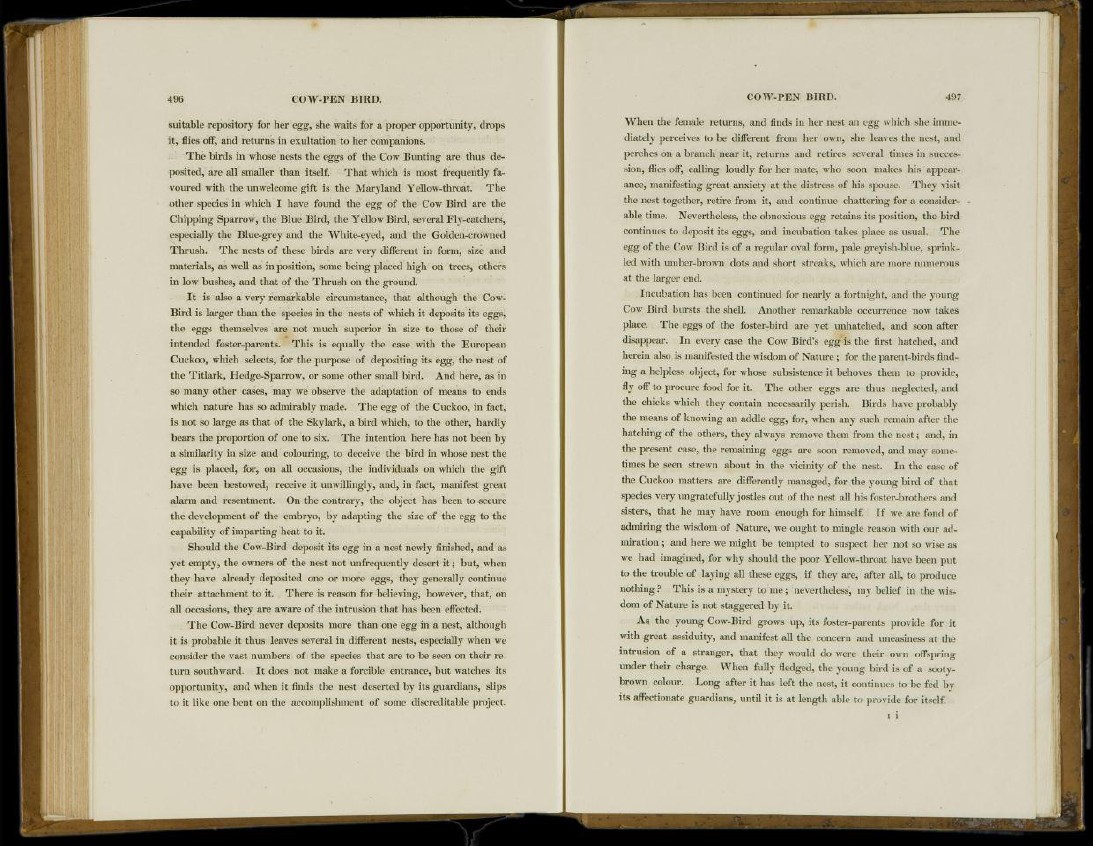
suitable repository for her egg, she waits for a proper opportunity, drops
it, flies off, and returns in exultation to her companions.
The birds in whose nests the eggs of the Cow Bunting are thus deposited,
are all smaller than itself. That which is most frequently favoured
with the unwelcome gift is the Maryland Yellow-throat. The
other species in which I have found the egg of the Cow Bird are the
Chipping Sparrow, the Blue Bird, the Yellow Bird, several Fly-catchers,
especially the Blue-grey and the White-eyed, and the Golden-crowned
Thrush. The nests of these birds are very different in form, size and
materials, as well as in position, some being placed high on trees, others
in low bushes, and that of the Thrush on the ground.
It is also a very remarkable circumstance, that although the Cow-
Bird is larger than the species in the nests of which it deposits its eggs,
the eggs themselves are not much superior in size to those of their
intended foster-parents. This is equally the case with the European
Cuckoo, which selects, for the purpose of depositing its egg, the nest of
the Titlark, Hedge-Sparrow, or some other small bird. And here, as in
so many other cases, may we observe the adaptation of means to ends
which nature has so admirably made. The egg of the Cuckoo, in fact,
is not so large as that of the Skylark, a bird which, to the other, hardly
bears the proportion of one to six. The intention here has not been by
a similarity in size and colouring, to deceive the bird in whose nest the
egg is placed, for, on all occasions, the individuals on which the gift
have been bestowed, receive it unwillingly, and, in fact, manifest great
alarm and resentment. On the contrary, the object has been to secure
the development of the embryo, by adapting the size of the egg to the
capability of imparting heat to it.
Should the Cow-Bird deposit its egg in a nest newly finished, and as
yet empty, the owners of the nest not unfrequently desert it; but, when
they have already deposited one or more eggs, they generally continue
their attachment to it. There is reason for believing, however, that, on
all occasions, they are aware of the intrusion that has been effected.
The Cow-Bird never deposits more than one egg in a nest, although
it is probable it thus leaves several in different nests, especially when we
consider the vast numbers of the species that are to be seen on their return
southward. It does not make a forcible entrance, but watches its
opportunity, and when it finds the nest deserted by its guardians, slips
to it like one bent on the accomplishment of some discreditable project.
When the female returns, and finds in her nest an egg which she immediately
perceives to be different from her own, she leaves the nest, and
perches on a branch near it, returns and retires several times in succession,
flies off, calling loudly for her mate, who soon makes his appearance,
manifesting great anxiety at the distress of his spouse. They visit
the nest together, retire from it, and continue chattering for a considerable
time. Nevertheless, the obnoxious egg retains its position, the bird
continues to deposit its eggs, and incubation takes place as usual. The
egg of the Cow Bird is of a regular oval form, pale greyish-blue, sprinkled
with umber-brown dots and short streaks, which are more numerous
at the larger end.
Incubation has been continued for nearly a fortnight, and the young
Cow Bird bursts the shell. Another remarkable occurrence now takes
place. The eggs of the foster-bird are yet unhatched, and soon after
disappear. In every case the Cow Bird's egg is the first hatched, and
herein also is manifested the wisdom of Nature ; for the parent-birds finding
a helpless object, for whose subsistence it behoves them to provide,
fly off to procure food for it. The other eggs are thus neglected, and
the chicks which they contain necessarily perish. Birds have probably
the means of knowing an addle egg, for, when any such remain after the
hatching of the others, they always remove them from the nest; and, in
the present case, the remaining eggs are soon removed, and may sometimes
be seen strewn about in the vicinity of the nest. In the case of
the Cuckoo matters are differently managed, for the young bird of that
species very ungratefully jostles out of the nest all his foster-brothers and
sisters, that he may have room enough for himself. If we are fond of
admiring the wisdom of Nature, we ought to mingle reason with our admiration
; and here we might be tempted to suspect her not so wise as
we had imagined, for why should the poor Yellow-throat have been put
to the trouble of laying all these eggs, if they are, after all, to produce
nothing ? This is a mystery to me; nevertheless, my belief in the wisdom
of Nature is not staggered by it.
As the young Cow-Bird grows up, its foster-parents provide for it
with great assiduity, and manifest all the concern and uneasiness at the
intrusion of a stranger, that they would do were their own offspring
under their charge. When fully fledged, the young bird is of a sootybrown
colour. Long after it has left the nest, it continues to be fed by
its affectionate guardians, until it is at length able to provide for itself.
1 i